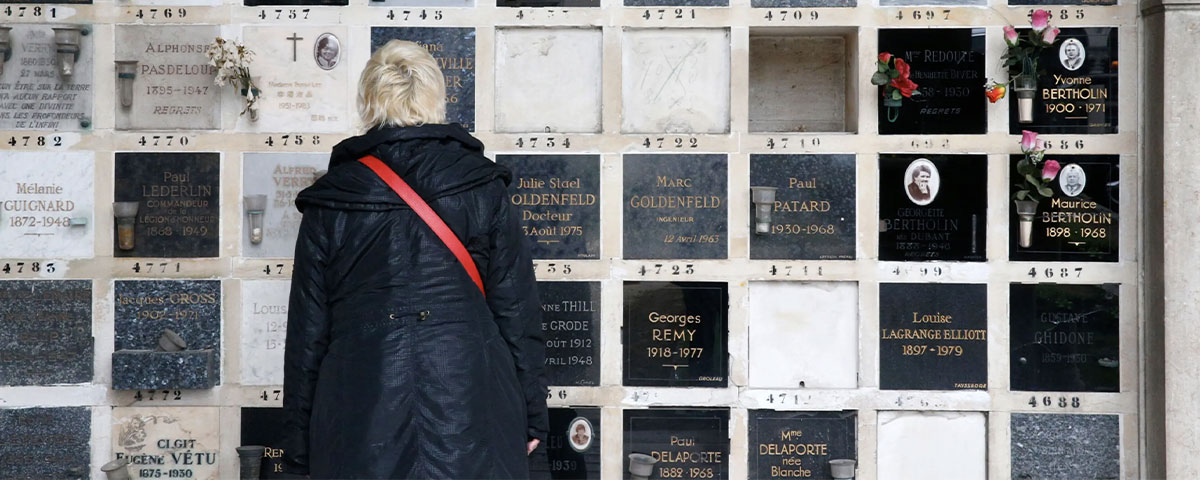Everything You Should Know About Burying Cremated Remains
As cremation becomes the dominant choice for the handling of human remains, families often find themselves floundering for the right way to provide a final rest for a loved one. For many people, burial would have been an ideal choice, due to religious beliefs or simple preference. If you’re planning for cremation, and you don’t know what to do with the ashes, you should know that burial is a great option to consider.
Burial of ashes, or interment, allows you to have a place that you or your family can visit. Interment also helps families to feel better about the idea of cremation, particularly if they choose it due to cost or other constraints. With this guide, you’ll understand how you can bury remains, where you can put ashes, what you can expect to pay for different options, and a few tips for hosting an interment ceremony.


Can You Bury Cremated Remains?
Although many people choose cremation because it gives them the option not to bury the remains of a loved one, interment remains one of the most popular choices for the disposition of cremated remains. Interment describes the process of burying human remains in the ground. You may choose to put the remains in a grave, but you can inter ashes in other places, such as a cemetery’s columbarium or an urn garden. The ability to have a place to go to visit your loved one, or offering the same to your loved ones when you pass, makes interment an important consideration.
Interment of remains isn’t the most popular choice for cremation, but almost a quarter of people who plan for cremation want some type of burial, according to a 2020 report by USA Today. If you’re debating between interment and having your ashes scattered or kept by a loved one, you’re in good company. Burying cremated ashes requires you to choose a suitable location, such as a cemetery. You can expect to pay $750 to $5,000 or more for the burial itself, depending mostly on whether you want an individual burial plot. You may also need to buy an urn in the appropriate material, and sometimes an urn vault.
When Should I Consider Interment of Remains?
Making a choice for your (or a loved one’s) final rest calls for careful consideration. Although you’re not required to choose burial for cremated remains, here are a few reasons that you may want to consider it.


Creating a Permanent Memorial
Although cremation has been a traditional choice in some cultures for millennia, it’s only been the default option in the U.S. for about a decade. Burying remains in a cemetery allows families to walk the line between a traditional burial and cremation. If your loved one wanted a traditional burial but could not afford it, or if their religion requires a burial, you can follow their wishes by interring the ashes. You can have a graveside service and install a headstone that provides a permanent memorial.
Being Able to Visit a Loved One’s Resting Place
Visiting a loved one on a favorite holiday or anniversary is an important part of the grieving process for those left behind. Many people like to visit their loved ones’ resting places on a regular basis. If you find that you’ll want to spend time with your loved one, even after they are gone, creating a permanent resting place can give you an ideal way to visit, on your own or with a small group.
Ensuring Affordability
Although interment of remains is one of the most expensive ways to handle ashes after cremation, the cremation process usually costs much less than a traditional casket burial. The National Funeral Directors Association notes that metal caskets and vaults for traditional burial cost $3,500 to $4,000, while urns and urn vaults cost $300 to $1,000. You can also find burial plots specifically sized for cremated remains that cost less than the price to buy a traditional plot.
Making a Safe Resting Place
Ultimately, interring remains in a cemetery, columbarium, or on your own private land gives you the comfort of a safe resting place. You don’t have to worry about the area being disturbed. If you don’t feel comfortable keeping ashes in your home due to the energy in cremated remains, and you don’t have a place you would like to scatter them, interment gives you the surety that a loved one can truly rest in peace.
Key Takeaway:
Just like a traditional burial, cremated remains can also be buried, or interred. Interment of remains is an ideal choice if you want to have a permanent memorial for your loved one that you can revisit, and it is more affordable than a traditional casket burial.
Where Can Ashes Be Interred?
If you want to bury a loved one’s cremated remains, you’ll need to choose a place. You have several options, depending on where you want to put them and your budget. Here are a few of the most common.
Cemetery
Interring cremated remains in a cemetery isn’t significantly different from a traditional burial. You’ll still need to buy a plot and arrange for a headstone after the burial. You may have options to get a plot sized specifically for urns, but you may also be able to buy a plot for traditional burial, cremation, or some combination of the two. To bury remains in a cemetery plot, you’ll also need an urn vault and an appropriate urn.
Columbarium
If you don’t want to buy a burial plot, or if your local cemetery has no plots available, you can consider buying a niche in a columbarium. A columbarium is a stationary building that holds cremated remains in niches. Many cemeteries offer columbaria niches, but you may also find them in a church, public monument, or other memorial location. Most columbaria have a front engraved plate to conceal the urn, but some may allow you to display the urn in a visible way.
Urn Garden
Many cemeteries offer urn gardens, which are areas of the cemetery with small plots meant to hold cremated remains only. You’ll typically need to buy an urn vault and headstone, and the cemetery may have special limits on certain features due to the size of the plot. Keep in mind that an urn garden is not the same thing as a scattering garden, which you may want to consider if you’re thinking about scattering the ashes of a loved one.
Private Property
Private property offers many of the benefits of burying cremated ashes in a cemetery, without the same cost and rules. If you want to build a columbarium or family mausoleum to hold the cremated remains of your loved ones, you can do that on private property. Remember that burying human remains on private property requires you to disclose the presence of the burial site, in the event that you decide to sell the property. In this case, you may want to bury the remains using an urn and urn vault, so you can relocate them if necessary.
Public Property
Just like scattering ashes on public land, you’ll need to get permission in advance before you bury remains in a public place. Many national parks and other public locations offer the ability to inter cremated remains on their ground. You may need to apply for a permit first, and they often set specific locations that you can use for the interment.
Green Burial
Some cemeteries may give you the option of choosing a green burial. In this type of burial, you may put the cremated remains into a biodegradable urn and bury them directly into the ground without a vault. Green burial plots usually have limits on the types of materials you can use for the burial. Be sure to consult the cemetery about your options before you buy an urn or arrange for treatment of the body.
Key Takeaway:
Ashes can be interred in a cemetery, columbarium, urn garden, or other private or public property. A columbarium will place urns in niches above ground, but for underground burial in a cemetery or urn garden, urns must be encased in an urn vault that protects the urn from the weight of the soil above it. Biodegradable urns are also an option for ground burial that allow the remains to disperse into the soil without an urn vault.
How Much Does It Cost to Bury Cremated Remains?
The cost to bury cremated remains ranges from $750 to $5,000 or more, according to a 2023 report by Choice Mutual. You’ll pay more to inter the remains in a burial plot, especially if you want a spot in a private cemetery. You may need to pay for some of these:
- Urn: $200 to $500 or more
- Urn Vault: $100 to $200 or more
- Cemetery Plot: $1,000 to $5,000
- Headstone: $1,000
- Columbarium Niche: $350 to $3,000
In most cases, the purchase of the plot or columbarium niche includes maintenance fees. You may need to pay extra for the actual interment of the remains.
Key Takeaway:
The cost of burying cremated remains can range between $700 to $5,000, depending on the location of the interment and maintenance fees for the plot or niche.
Which Urns Are Best for Interment of Ashes?
If you want to buy an urn for interment, you’ll need to choose the right materials. As a general rule, you should plan to use an urn vault for any in-ground interment except a green burial. When selecting urns, look for types with a sturdy design and materials that won’t break down over time. These urn materials can give you the best results:
- Metal: Metal urns are sturdy and less likely to crack or break due to the elements.
- Stone: Stone urns can support heavier weight, which may give you the option of burying the urn without an urn vault.
- Biodegradable Urns: You can choose an urn made of paper or other biodegradable materials, if you plan on a green burial.
If you opt for placement in a columbarium that allows you to display the urn, you can certainly choose materials and designs that are more delicate or ornate. Ask about climate control for the columbarium, before you select something that might crack due to changes in temperature or humidity.


How Can I Plan an Interment Ceremony?
As part of your planning, you may consider hosting an interment ceremony. Like a graveside service, an interment ceremony can accompany a funeral or memorial service, or stand on its own. This service allows the family and friends to see the burial location and say a final goodbye. If you want to plan an interment ceremony, you should consider following these tips:
- Plan ahead for the ceremony, including paying costs for services as needed.
- Set a date and location, and make sure that your attendees know how to find it.
- Make a guest list, and confirm that the location will be accessible to the people who want to attend.
- Hire an officiant, or designate a family member to lead the service.
- Create a ceremony program, featuring eulogies, poems, stories, music, or other tributes.
This ceremony can give you the freedom to explore ways to give your loved one the perfect sendoff. It’s a great opportunity to get creative and encourage others to participate.
Start Planning for Your Final Rest
When you choose cremation for the handling of your own body or that of a loved one, you get the option to customize it in ways you might never have imagined. If you long for a proper burial in a cemetery, you can have that choice, even for cremated remains. Just remember that you need to budget for the type of burial that you want, and buy an urn that will work for the burial plot, columbarium niche, or green burial place. By following this advice, you can start planning for a wonderful and respectful final rest.
MEET THE FOUNDER
Susan Fraser
Susan Fraser, founder of In the Light Urns, Inc., has spearheaded innovation in the memorial industry since 2001. After a personal tragedy, she began creating custom cremation urns for ashes that reflect a lost loved one's individuality. Susan's commitment to comfort makes her an authority on cremation and memorials, guiding and consoling families through understanding and compassion. With expertise and dedication, Susan's cremation guides give families invaluable resources for informed decisions.


Cremation Education
Cremation education informs diverse practices and ethics, empowering informed end-of-life choices.







